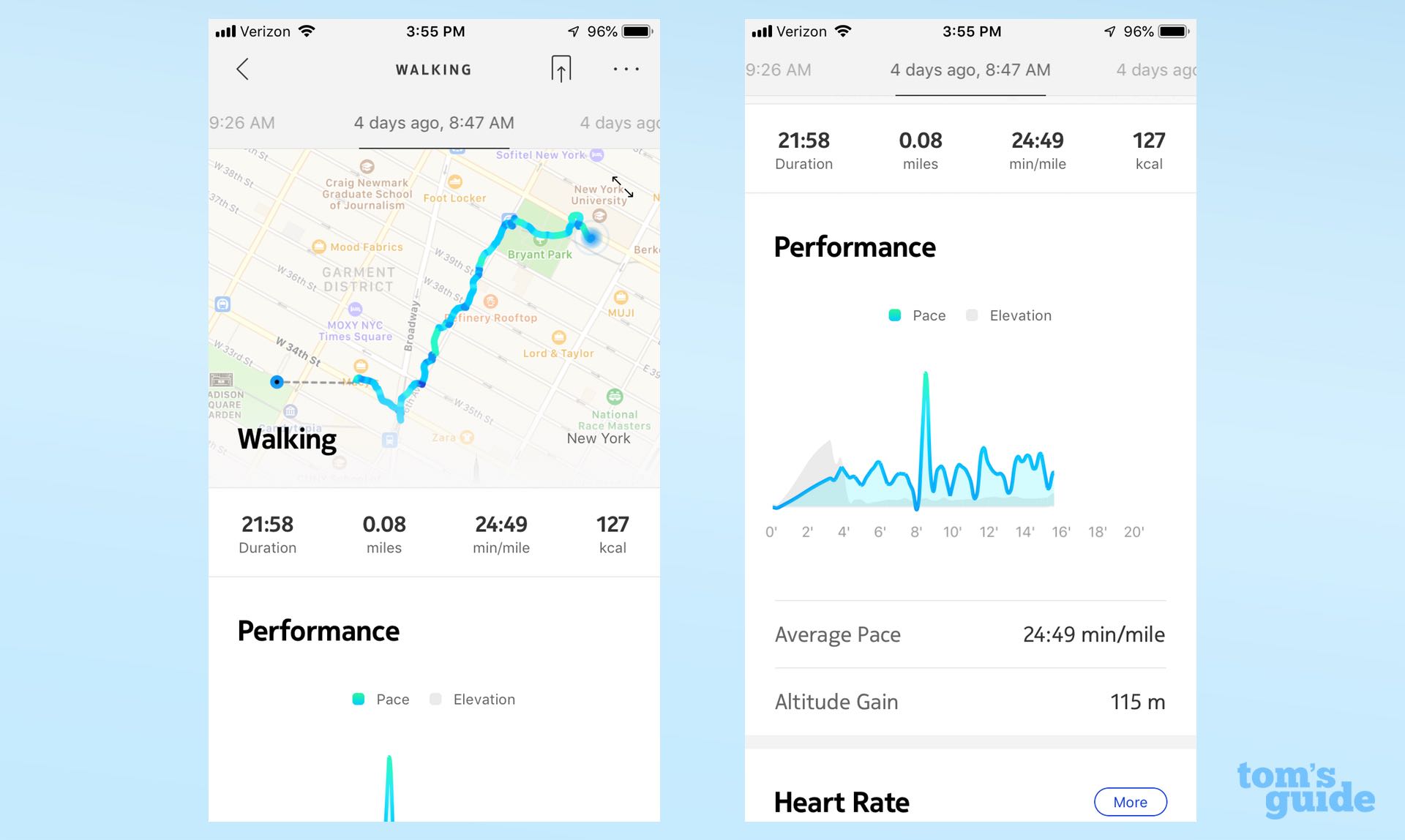Tom's Guide Verdict
We really like the look of the Withings Steel HR Sport as well as its 20-day battery life, but it's expensive for the features you get.
Pros
- +
Great design
- +
Long battery life
- +
Clean, intuitive app
Cons
- -
Flimsy charging cradle
- -
OLED screen hard to read in sunlight
- -
Fewer features than Fitbit Charge
Why you can trust Tom's Guide
Withings is back. Two years after it was bought by Nokia — and four months after it was bought back by its founder — Withings has a new fitness tracker.

The Steel HR Sport ($199) looks nearly the same as its predecessor, which we praised for its design and battery life. While the watch has a handful of new features, it's largely the same as before — which is both good and bad.
Withings Steel HR Highlights
- Who is it for? People who want a fitness watch that looks like a regular watch. The design is nice, but the OLED screen is hard to read in the sun.
- What does it track? Heart rate, steps, distance and calories as well as running, swimming, biking and 30 other activities
- Is there GPS? No, but you can get location through your phone.
- How long is the battery life? Up to 25 days, or 20 days with activity tracking.
Design: If it ain't broke ...
The design of the Withings Steel HR Sport is more or less identical to the Withings Steel HR from early 2017. Not that that's a bad thing — I love the traditional analog watch face, the subdial at the bottom and the small, circular OLED display that shows you such things as your heart rate, incoming calls, calendar notifications and more. Its most direct competitor is the Garmin Vivomove HR, which also has a traditional watch design with a small OLED screen but lacks a subdial.

Having recently worn other, much larger smartwatches, such as the Samsung Galaxy Watch (46 millimeters), the 40-mm Withings Steel HR Sport made me feel like I was wearing a kid's watch. However, its smaller size will no doubt appeal to those with smaller wrists. It looked just right on my colleague Caitlin.
The Steel HR Sport is all black, with red accents at the tips of the hour and minute hands. A button on the right side of the watch lets you switch between screens. Its size belies its strength: The watch is made of stainless steel and can withstand being submerged to a depth of 50 meters.
The watchband has a sporty-ish look, with perforations running along its length. However, its black-and-gray motif makes it aesthetically acceptable to wear in more professional settings.
OLED Display: Small size has its compromises
When not in use, the Steel HR's OLED screen more or less blends in with the rest of the watch face. (If you get the version of the watch with the white face, the black OLED screen stands out prominently.) Press the side button on the watch, or receive a notification, and it pops to life: The number or message scrolls across the diminutive display, and the watch vibrates gently.

As you're working out, the Steel HR Sport's OLED display will remain on, showing your heart rate at a glance. However, its small size makes it difficult to read when you're running. Bright sunlight, which can wash out the display, only exacerbates the issue. Make sure the screen brightness is at max.
We had a similar issue with the Vivomove HR; its white text was simply too hard to read in sunlight. You can do more with it, though: Its touch-screen interface can be used to control music playback on your smartphone, for instance.
Activity Tracking
Pressing the side button lets you view your heart rate, steps, distance traveled, calories burned, alarms and battery life.

If you press and hold the button, you'll launch the watch's activity-tracking mode, which allows you to select from running, swimming, biking, walking and other. According to Withings, "other" encompasses 30 different activities, including yoga, volleyball, rowing, boxing, skiing and ice hockey. From the app, you can choose which of these shows up on the Steel HR's display.
Another long press starts the activity, and another long press will stop active tracking. It's simple, and it works. Although we were somewhat down on it when we originally tested it, the Vivomove HR would automatically start tracking activities.

If you have your phone with you, the watch will use its GPS to more accurately track your location and distance during your activity. On a one-mile walk through midtown Manhattan, the app recorded my route accurately, but somehow thought I had walked less than a tenth of a mile. My distance was recorded accurately on other activities — the skyscrapers of New York can often confuse GPS devices.
The Steel HR Sport's heart rate monitor also proved accurate, but given the watch's small display and lack of other advanced metrics you'd find on devices such as the Garmin Forerunner 35, it's not one I would recommend for anything more than causal exercise.
MORE: 10 Most Surprising Uses for Fitness Trackers
While the Steel HR Sport also tracks sleep and can calculate your VO2 Max — a good estimation of your overall fitness level — you won't find a number of the features found on the Fitbit Charge 3. For example, on the Steel HR, there's no way to pause a workout, it doesn't count things such as laps in the pool, nor is there a SpO2 sensor, which can be used to track things such as sleep apnea. Nor does it have such things as period tracking, guided breathing sessions and mobile payments.
App: Clean and too simple
Withings provided me with a beta version of its updated HealthMate app, which will roll out to all users when the new watch goes on sale. For those who currently have an older Withings or Nokia fitness tracker, fear not: Your device will work with this app, too.

Similar to Fitbit, the Withings app has a nice, clean look: When you open it, you're presented with your latest activity and step count on a white background that fills the main part of the screen. Scroll down the page, and you'll see data for previous days' activities. Along the bottom are several icons: dashboard (which shows data collected by the watch and other Withings devices, such as its smart scale), Devices, Profile and Programs.

If you have a tracked workout, you can see charts for your pace, elevation and heart rate. Sadly, while you can overlay the charts for pace and elevation, you can't for heart rate.
MORE: Fitness Trackers - Latest Health and Activity Trackers
The last of these, Programs, provides guides for several wellness programs to help monitor and improve various aspects of your health. These include a pregnancy tracker, sleep monitor and one that analyzes your blood pressure. For each of these programs, equipment other than the Steel HR Sport may be required.
Battery Life
The Steel HR Sport sits in a small USB charging cradle: Don't jostle it too much, or you'll lose the connection. Fortunately, you shouldn't have to use it too often: According to Withings, the watch will last up to 20 days on a charge, which you can stretch to 25 if you turn off activity tracking.

That's a lot longer than you'll get from any other fitness tracker. The Vivomove HR lasts about four days, the Fitbit Charge 2 five days and the Fitbit Charge 3 is expected to last seven days.
Bottom Line
I was very glad to see Withings return after Nokia's bumbling. And, for better and worse, not much has changed with the new Steel HR Sport. Among fitness trackers, it has a design that doesn't scream, "I'm a fitness tracker," making it blend in better with whatever you're wearing. Only Garmin's Vivomove HR comes close to replicating the Steel HR's look. And, the Steel HR's extraordinary battery life far surpasses the competition.
But at $199, it's expensive for a somewhat casual fitness tracker; while the Vivomove HR costs as much, at least that watch's display is touch-sensitive. The upcoming Fitbit Charge 3, while not nearly as stylish, is $70 less and can do a lot more. The Withings Steel HR Sport is a great-looking fitness tracker with great battery life — and yet, I was hoping for more.
Credit: Tom's Guide

Michael A. Prospero is the U.S. Editor-in-Chief for Tom’s Guide. He oversees all evergreen content and oversees the Homes, Smart Home, and Fitness/Wearables categories for the site. In his spare time, he also tests out the latest drones, electric scooters, and smart home gadgets, such as video doorbells. Before his tenure at Tom's Guide, he was the Reviews Editor for Laptop Magazine, a reporter at Fast Company, the Times of Trenton, and, many eons back, an intern at George magazine. He received his undergraduate degree from Boston College, where he worked on the campus newspaper The Heights, and then attended the Columbia University school of Journalism. When he’s not testing out the latest running watch, electric scooter, or skiing or training for a marathon, he’s probably using the latest sous vide machine, smoker, or pizza oven, to the delight — or chagrin — of his family.
